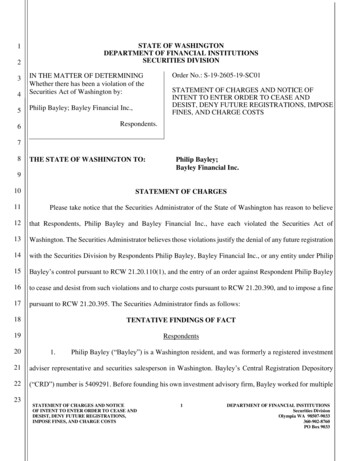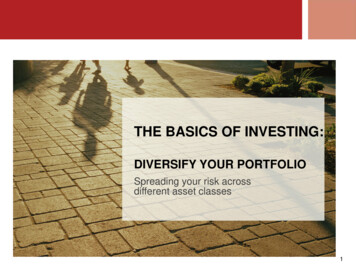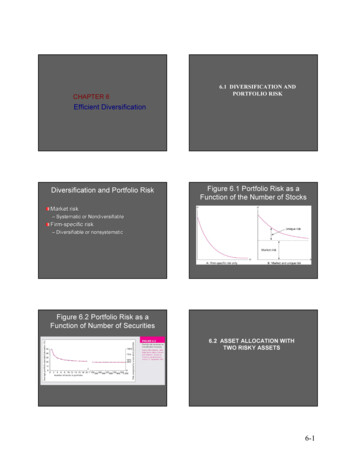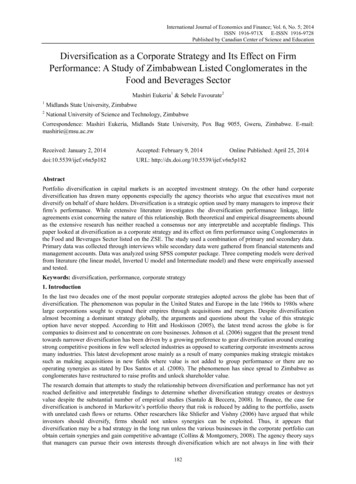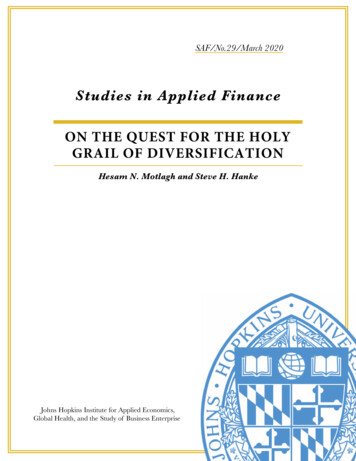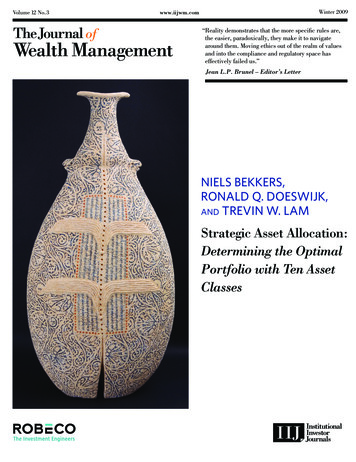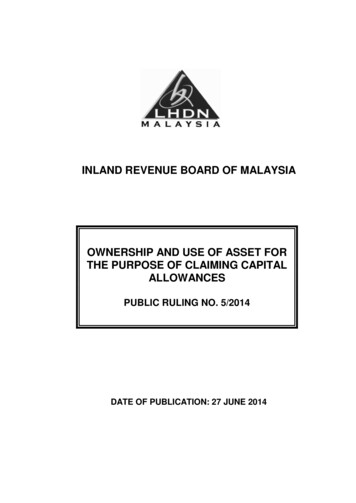
Transcription
The Benefits of Diversification: Asset ClassesIncluded in Schwab Intelligent PortfoliosKey Points Long-term, strategic asset allocation and diversification is the basis of the Schwab IntelligentPortfolios investment strategy.All else equal, diversification lowers portfolio risk and can lead to higher wealth in the long run.Schwab Intelligent Portfolios invests in a broad range of asset classes, each of which serves aunique role and purpose in a diversified portfolio.IntroductionAsset allocation—dividing an investment portfolio into different asset classes, such as stocks,bonds, commodities, and cash investments—has been the cornerstone of portfolio constructionfor decades. The goal of asset allocation is to reduce risk through diversification by combiningexposures to a variety of investments that have historically performed differently during variousmarket conditions.This paper provides a brief overview of diversification and explains the asset classes andinvestment strategies offered in Schwab Intelligent Portfolios.Diversification: "the only free lunch in finance"Nobel Prize-winning economist Harry Markowitz once called diversification "the only free lunchin finance," and this well-known concept forms the basis of our investment strategy.Diversification makes intuitive sense—when one asset class suffers, it pays to not have all youreggs in one basket. Mathematically, diversification is made possible by the fact that individualassets typically aren't perfectly correlated. In other words, if asset values do not move up anddown in perfect harmony, then a diversified portfolio will have less risk than the weightedaverage risk of its constituent parts.The benefits of diversificationThe example below looks at the historical performance of 100,000 invested in a 100% stockportfolio compared to a 60% stock, 40% bond portfolio over the 20 year period from December1999 to March 2020. Interestingly, a 60/40 portfolio slightly outperformed an all stock portfolioand did so with meaningfully less volatility as seen by the reduced drawdown during the socalled "tech bubble" in 2002, the great recession in 2009, and the COVID-19 global pandemic inMarch 2020. This example demonstrates the benefit that asset allocation and diversification canoffer: better risk-adjusted returns. This can be advantageous when growing wealth over time. It'snot immediately obvious, but the reason lower portfolio risk can lead to higher wealth in the longrun is that a portfolio with lower risk generally does not decline as much in a market downturn,
so it has less ground to recover to get back to breakeven compared to a portfolio that saw a largerdecline. For example, a portfolio that falls in value by 50% must grow by 100% to recover fromits loss; a portfolio that declines by 10% only needs to grow by 11% to recover.Exhibit 1: Historical performance of 100,000 investment: 1999-2019The benefits of diversification can also be visualized using the quilt chart below which ranks (topto bottom) the annual performance of various asset classes from 2010 to 2019. For example, cashinvestments, as measured by Treasury bills, were the best performing asset class in 2018, butsubsequently, the worst-performing asset class in 2019. By contrast, international stocks were theworst-performing asset class in 2018, but they had been among the best-performing in 2017.Such charts highlight the stark changes in asset class performance year-to-year, not to mentionthe difficulty in predicting which asset class will be at the top. Rather than trying to forecastperformance, investing in a diversified portfolio across asset classes helps to ensure that at anygiven time the portfolio will hold some of the top performers while not being overlyconcentrated in the bottom performers as they shift from year to year.
Exhibit 2 : Annual performance of various asset classes: 2009-2019Source: Morningstar Direct. Data is from January 1, 2009- December 31, 2019. This chartrepresents a hypothetical investment and is for illustrative purposes only. Diversificationstrategies do not ensure a profit and do not protect against losses in declining markets. Pastperformance is no indication of future results. See Full Disclosure of chart and indices in theback of the document under Important Information.Asset classes included in Schwab Intelligent PortfoliosWe were deliberate and thoughtful when choosing the asset classes to include in SchwabIntelligent Portfolios. Selected investments should provide unique risk or return characteristicsand be as minimally correlated as possible in order to take advantage of the benefits ofdiversification. Said differently, Schwab Intelligent Portfolios invests in a variety of U.S. andinternational asset classes to diversify each portfolio's sources of risk and return, whether that is
from domestic or international corporate earnings, interest rates, inflation, or currencies. Thetable below shows the 20 expanded asset classes available in Schwab Intelligent Portfolios.Exhibit 3: Schwab Intelligent Portfolios expanded asset classes and definitionsStocksU.S. Large CompanyStocksU.S. Large CompanyStocks–FundamentalU.S. Small CompanyStocksU.S. Small CompanyStocks–FundamentalInternationalDeveloped LargeCompany StocksInternationalDeveloped LargeCompany Stocks–FundamentalInternationalDeveloped SmallCompany StocksInternationalDeveloped SmallCompany Stocks–FundamentalInternationalEmerging MarketsStocksInternationalEmerging MarketsStocks–FundamentalDescriptionLarge company stocks—or "large caps"—are investments in the equity of largerU.S. companies, generally those with more than 10 billion in marketcapitalization, such as Exxon Mobil Corporation or Microsoft Corporation.U.S. large company stocks—fundamental are investments of larger U.S.companies that are included in fundamental indexes, which screen and weightcompanies based on fundamental factors such as sales, cash flow anddividends.U.S. small company stocks—or "small caps"—are investments in the equity ofsmaller U.S. companies, generally those that represent the bottom 10% of themarket by cumulative market capitalization.U.S. small company stocks—fundamental are investments in the equity ofsmaller U.S. companies that are included in fundamental indexes, which screenand weight companies based on fundamental factors such as sales, cash flowand dividends.International developed large company stocks are investments in the equity oflarger foreign companies that have high market capitalizations and are based incountries with mature economies.International developed large company stocks – fundamental are investmentsin the equities of larger foreign companies that are included in fundamentalindexes, which screen and weight companies based on fundamental factorssuch as sales, cash flow and dividends.International developed small company stocks are investments in the equity ofsmaller foreign companies that are based in countries with mature economiesand stock markets that benefit from strong investor protections, corporategovernance and legal infrastructure.International developed small company stocks - fundamental are investmentsin the equities of smaller foreign companies that are included in fundamentalindexes, which screen and weight companies based on fundamental factorssuch as sales, cash flow and dividends.Emerging market stocks are equity investments in foreign companies domiciledin countries with developing economies that have been experiencing rapidgrowth and industrialization.International emerging market stocks—fundamental are investments in theequity of foreign companies that are based in countries experiencing rapidgrowth and industrialization, and are included in fundamental indexes, whichscreen and weight companies based on fundamental factors such as sales, cashflow and dividends.
U.S. ITSU.S. High DividendStocksInternational HighDividend StocksMaster LimitedPartnershipsFixed IncomeU.S. TreasuriesU.S. InvestmentGrade CorporateBondsU.S. SecuritizedBondsU.S. InflationProtected BondsU.S. CorporateHigh Yield BondsInternationalDevelopedCountry BondsInternationalEmerging MarketsBondsU.S. exchange-traded REITs (Real Estate Investment Trusts) are investments inreal estate investment trusts focused on real estate and/or mortgages ormortgage securities traded on U.S. exchanges. REITs must pay 90% of theirtaxable income to shareholders every year.International exchange-traded REITs are investments in real estate investmenttrusts focused on real estate and/or mortgage securities traded in foreigncountries.U.S. high dividend stocks are investments in the equity of U.S. companies thattend to distribute higher-than-average dividends to shareholders.International high dividend stocks are investments in the equity of foreigncompanies that tend to distribute higher-than-average dividends.MLPs trade publicly on a securities exchange like stocks and often pay highlevels of income. To qualify as an MLP, a partnership must generate at least90% of its income from what the Internal Revenue Service considers to be"qualifying" sources, including activities related to real estate, or theproduction, processing or transportation of oil, natural gas, coal and othercommodities.DescriptionTreasuries are debt securities of the U.S. government issued through the U.S.Department of the Treasury at various maturities, from one year or less to as long as30 years.U.S. investment grade corporate bonds are investments in the debt of U.S.corporations with relatively high credit ratings provided by one or more of the majorU.S. credit rating agencies.U.S. securitized bonds are securities in which principal and interest payments arebacked by cash flows from a particular asset or pool of assets, such as mortgagebased securities from government agencies or government-sponsored enterpriseslike Ginnie Mae and Fannie Mae.U.S. inflation protected bonds are securities issued by the U.S. Treasury that protectinvestors against inflation by adjusting the principal value based on changes in theU.S. Department of Labor's Consumer Price Index.U.S. corporate high yield bonds—sometimes known as "junk bonds"—areinvestments in the debt of U.S. corporations with lower credit ratings provided by themajor U.S. credit rating agencies.International developed country bonds are debt instruments issued by agovernment, agency, municipality or corporation based in a highly developed countryother than the U.S. International developed country government bonds typicallycarry investment grade credit ratings, but some may be rated below investmentgrade.International emerging market bonds (EM bonds) are issued by a government,agency, municipality or corporation domiciled in a developing country.
PreferredSecuritiesPreferred securities are a "hybrid" investment, sharing characteristics of both stocksand bonds. Like stocks, they are generally paid after a company's bonds in the eventof a corporate liquidation. Like bonds, however, they generally make regular fixedpayments and have a par value that can rise or fall as interest rates change.Bank loans are originated by banks and sold to institutional investors like mutualfunds or ETFs. The loans are made to corporations, which use them to fundacquisitions and other strategic initiatives. The loans typically have floating rates,meaning they pay a set amount over a benchmark interest rate, often the 3-monthLondon Interbank Offered Rate (Libor).Bank LoansInvestment GradeMunicipal BondsInvestment grade municipal bonds are investments in bonds issued bymunicipalities—cities, states, counties—as well as enterprises that serve a publicpurpose, such as universities, hospitals and utilities.CommoditiesGold and Other PreciousMetalsDescriptionPrecious metals include gold, silver, platinum, and other preciousmetals.CashDescriptionFDICinsuredCashThe FDIC-insured cash allocation in Schwab Intelligent Portfolios is invested in the SchwabIntelligent Portfolios Sweep Program, which is sponsored by Charles Schwab & Co., Inc.Asset Class Roles within the PortfolioTo understand the rationale behind each asset class, it's helpful to group them according to theirroles in the portfolio.Exhibit 4: Expanded asset class roles
Growth potential will come primarily from the equity allocations (U.S. large-company, U.S.small-company, international developed country large-company, international developed countrysmall-company and international emerging markets). These asset classes have historicallydelivered the highest returns, with a correspondingly higher risk. Most long-term investorsshould have at least some exposure to all of the major equity markets.For investors focused on a more yield-oriented, or income-generating, portfolio, growth potentialand income will come from dividend-paying stocks (U.S. and international), as well as yieldoriented securities such as master limited partnerships (MLPs). These securities offer thepotential for both high returns and high yield.Income will come from a broad array of fixed income investments, including U.S. investmentgrade corporate bonds, U.S. corporate high yield bonds, U.S. securitized bonds, internationalemerging market bonds, preferred stocks, bank loans and other floating-rate notes. Incomegenerally accounts for the majority of a bond's total return; as such, bonds do not typically offersignificant opportunities for growth. While bonds historically have provided higher levels ofincome, they carry varying degrees of risk.Inflation protection comes from allocations to U.S. inflation protected bonds, and real estateinvestment trusts (REITs). With U.S. inflation protected bonds, the principal value adjustsupward with inflation. As U.S. inflation protected bonds have a constant coupon rate, thisimplies that the coupon, or interest received, grows with inflation.
Defensive assets are those that tend to perform well when there is downward pressure on equities(low or negative correlations with equities). Examples of defensive assets include Treasurysecurities, gold, international developed country bonds, and FDIC-insured cash.Further detail and specifics on each asset class can be found in the Schwab Intelligent PortfoliosGuide to Asset Classes & ETFs.Market capitalization versus fundamentally weighted indicesLow-cost, index investing is traditionally based on what's known as market-capitalizationweighted indices. This means that, all else equal, a stock portfolio that takes an index investingapproach would be concentrated in the largest companies within an asset class. As an example,the largest 10 companies in the S&P 500 Index made up more than 25% of the entire index.1 Italso means that, as the price of a security increases, so does its weighting, or proportion, of theportfolio. This can result in an overweight to the most overvalued companies and an underweightto the most undervalued companies (or at least those whose price has appreciated or depreciated,respectively). This is a contradiction to the "buy low, sell high" mantra. Though traditionalmarket cap index investing is dirt cheap and remains a powerful way to invest in an asset class ormarket segment at a very low cost.Over the past decade or so, "smart beta" or fundamentally weighted indices have gained inpopularity as a low-cost alternative to traditional, market-capitalization weighted index investing.The weight of a company in a fundamentally weighted index is typically determined usingmetrics of intrinsic value other than price such as revenue, cash flow, or book value.Based on research by Charles Schwab Investment Advisory Inc.2 and others, adding fundamentalstrategies in combination with market cap strategies can be beneficial to a portfolio over the longterm. Schwab Intelligent Portfolios invests in both market capitalization and fundamentallyweighted index products across all of its major equity asset classes (U.S. large company, U.S.small company, international large company, international small company, and emergingmarkets).Schwab Intelligent Portfolios strategiesGlobal strategiesThe Schwab Intelligent Portfolios global strategies are our flagship strategies, designed to offerbroad and well-diversified exposure to domestic, international, and emerging market economies.Depending on your risk profile, you will be invested in a mix of stocks, fixed-income assetclasses and cash based on your goal, time horizon and both willingness and capacity to take risk.While portfolios are generally diversified across stocks and bonds, more conservative portfoliosput more emphasis on bonds while more aggressive portfolios put more emphasis on stocks. Youmay also have a small allocation to gold or other precious metals.
U.S.-focused strategiesWe also offer strategies with less exposure to international and emerging market economies forthose of you with a preference for more U.S.-domiciled investments. U.S.-focused portfolios alsoinclude a mix of stocks, fixed income, and cash based on your goal, time horizon and riskprofile, but they emphasize domestic investments. While we believe that the U.S. isn't the onlygame in town, we understand the desire for a "home bias" and the familiarity with and preferencefor more developed economies (the domestic-focused strategies do not have any allocation toemerging markets). A portfolio concentrated in one geographical region may see higher volatilityover time which is why most of our U.S.-focused portfolios maintain a small allocation tointernational developed large cap stocks.Income-focused strategiesSchwab Intelligent Portfolios also offers strategies that are focused on investments that pay out ahigher percentage of their earnings to investors in the form of interest or dividend payments.These strategies include more exposure to so-called "blue-chip" companies and also includehigher yielding asset classes such as preferred stocks, master-limited partnership, bank loans andother short-term floating-rate notes. The income-focused strategies do not have any allocation togold or other precious metals.Municipal bond variationsFor taxable accounts and investors in higher tax-brackets, we also offer versions of each of thestrategies above with federally tax-exempt municipal bonds. Depending on the state you live in,bond interest may also be exempt from state income taxes. Municipal bonds typically pay outless interest than comparable fixed-income alternatives but, depending on your unique taxsituation, can offer attractive after-tax returns. We swap out the fixed-income allocations toTreasuries, corporate bonds, and agency mortgage-backed securities for investment-grademunicipal bonds. For Californians, we offer a version of our strategies concentrated inCalifornia-specific municipal debt.Exhibit 5: Schwab Intelligent Portfolios asset classes based on strategies offered
ConclusionThis paper provides an overview of the vast universe of expanded asset classes SchwabIntelligent Portfolios invests in, and the various investment strategies we offer depending on yourunique preferences and situation. We believe in the power of diversification, and this is reflectedin the way we create portfolios. See our follow-on paper on portfolio construction for a deeperdive. For those interested, we also have a separate article that explains how we select theparticular funds and ETF providers for every asset class.1. As of 3/31/2020. The largest 10 companies were Microsoft, Apple, Amazon, Facebook, BerkshireHathaway, Alphabet (Google), Johnson & Johnson, JP Morgan Chase, and Visa. The weight of thelargest constituent, Microsoft, was more than 5% of the index, even though the index iscomprised of approximately 500 companies.2. Peterson, Murphy (2019) "Better Together: Fundamental & Market-Cap Indexing"DisclosuresDeposit Balances held in the Sweep Program at Schwab Bank are eligible for FDIC insurance upto allowable limits.Diversification and rebalancing strategies do not ensure a profit and do not protect against losses indeclining markets. Investing involves risk including loss of principal.The information here is for general informational purposes only and should not be considered anindividualized recommendation or personalized investment advice. The type of securities and investmentstrategies mentioned may not be suitable for everyone. Each investor needs to review an investmentstrategy for his or her own particular situation. Data here is obtained from what are considered reliablesources; however, its accuracy, completeness or reliability cannot be guaranteed.Indexes are unmanaged, do not incur management fees, costs and expenses, and cannot be invested indirectly.Exhibit 2 Asset Class Performance Quilt Chart: This chart represents a hypothetical investment and is forillustrative purposes only. Diversification strategies do not ensure a profit and do not protect againstlosses in declining markets. Core bonds consists of Treasuries, investment-grade corporate bonds andsecuritized bonds. The diversified portfolio is a hypothetical portfolio consisting of 19% U.S. large capstocks (S&P 500 Index); 11% U.S. small cap stocks (Russell 2000 Index); 12% international developedmarket large cap stocks (MSCI EAFE Index); 7% international developed market small cap stocks(MSCI EAFE Small Cap Index); 7% emerging markets stocks (MSCI Emerging Markets Index); 3% U.S.REITs (S&P U.S. REIT Index); 2% international REITs (S&P Global REITs ex-U.S. Index); 7.5%Treasuries (Bloomberg Barclays 3-7 Year Treasury Bond Index); 1% investment-grade corporate bonds(Bloomberg Barclays U.S. Corporate Bond Index); 6% securitized bonds (Bloomberg Barclays U.S.Securitized Bond Index); 7% Treasury Inflation Protected Securities (Bloomberg Barclays U.S. TIPSIndex); 3% high-yield bonds (Bloomberg Barclays Very Liquid High Yield Bond Index); 2% emergingmarkets bonds (JPMorgan GBI-EM Diversified 15% Cap 4.5% Floor Index); 2% gold and other preciousmetals (S&P GSCI Precious Metals Index); 10.5% cash (Bloomberg Barclays 1-3 Month Treasury BillIndex). Including fees and expenses in the Diversified portfolio would lower returns. The portfolio isrebalanced annually. Returns include reinvestment of dividends, interest, and capital gains.
(0820-0DUL)
The Benefits of Diversification: Asset Classes Included in Schwab Intelligent Portfolios Key Points Long-term, strategic asset allocation and diversification is the basis of the Schwab Intelligent Portfolios investment strategy. All else equal, diversification lowers portfolio risk and can lead to higher wealth in the long run. Schwab Intelligent Portfolios invests in a broad .


